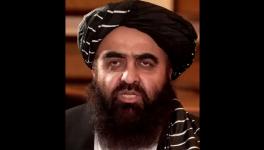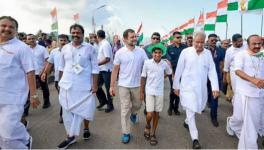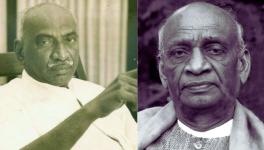Why Modi’s Narrative on Somnath Temple Needs to be Challenged
Representational use only.
Prime Minister Narendra Modi unveiled a slew of religio-tourism projects at the Somnath Temple, Gujarat, recently. In his customary address, Modi spoke in characterise style, once again trying to place issues of Hindu pride, lost glory and Hindutva at the top of the national agenda.
This was an unveiled attempt to sweep beneath the carpet, a host of failures and non-deliveries that are behind the recent unprecedented fall in his personal ratings. The effort was clearly to elevate to the numero uno position that single-point agenda of Hindu glorification / Muslim vilification and promotion of the Hindutva ideology from which this regime draws legitimacy.
The unfortunate facet of Indian politics is that none of those who fancy their chances of challenging him in the next hustings in 2024 contested any of Modi's articulations, significantly made merely a day before a Muslim man, selling bangles, was thrashed by a group of men in Madhya Pradesh’s Indore city.
This incident, the latest in series of incidents of hate violence against Muslims in several parts of India, also found little condemnation from mainstream Opposition parties. This suggests that targeting of Muslims and accepting verdicts of kangaroo courts is the new normal in India.
It is not that the decision to launch or inaugurate the projects in and around the temple complex, these included an opulent 1.48 km-long promenade along the Arabian Sea and the ground-breaking ceremony of yet another new temple to deify Parvati, required questioning. The only rider that could have been added was its timing, if this is an appropriate time for launching efforts at bolstering faith-based responses.
But, several of Modi's assertions, including distinct homilies, like "faith cannot be crushed by terror", "evil forces which conjure of establishing an empire on the basis of terror may dominate for some time during a particular period, but their existence is never permanent", and that these home truths "were true even when some despots were demolishing Somnath temple and also holds true today when the world is apprehensive of such ideologies," required to be taken on for the contextualisation and inferences he was drawing.
Modi has perfected the art of blowing the dog whistle. Thereby, at a time when the world is being fed with a single and linear narrative on Taliban’s seize of power in Afghanistan and the 'excesses' being committed, the real intention of Modi referencing the impermanent character of reigns of terror cannot be missed.
Just as the RSS-BJP (Rashtriya Swayamsevak Sangh and the ruling Bharatiya Janata Party) constantly claims continuity of 'glorious' Hindu character and society for millennia, Modi was implicitly drawing parallels between current developments in Afghanistan with the 'repeated destruction' of the Somnath temple through the ages with the intention of establishing a common lineage.
In any case, condemning the Taliban takeover in Afghanistan is now the new loyalty test for Muslims, as well as non-supporters of the sangh parivar. Not a day goes by that the troll army doesn't post, 'why are they silent on Taliban takeover.' It is a different matter that most of these ghost writers read little beyond their own posts and remain unaware of the discourse within the Muslim community and members of the secular civil society.
Not the Somnath development projects per se, but Modi's narrative on Somnath required to be challenged, because his ostensible claim of ushering the era of Hindu civilisational assertion over past Muslim hegemony is the principle ammunition left in the BJP-RSS weaponry for future elections, both Assembly and parliamentary in 2024.
Ever since the Ram Janmabhoomi agitation was launched in the mid-1980s, the reconstruction of the Somnath temple post-Independence provided the principal basis for the demand for the Ram temple at Ayodhya. But it gnawed the sangh parivar and its leaders, Modi included, from within for having no part in its restoration.
In his case this was true for even Ayodhya, as Modi had no role in the agitation, having been a state-level leader of the BJP till 1992. It is a paradox that the prime minister would have had no, or little space in history, if not for the Godhra carnage and subsequent Gujarat riots, directly a consequence of Vishwa Hindu Parishad’s adventurism in Ayodhya, even though he played just a marginal role in events leading to Babri Masjid's demolition.
This void in Modi's political C.V was filled last year when he performed Bhoomi Pujan for the being-constructed Ram temple at Ayodhya. By flagging the Somnath projects and inaugurating the promenade, Modi has put his signature on another flagship scheme of the Hindutva brigade. The Opposition's silence has enabled the Prime Minister to get away with this.
Opposition leaders, and even civil society, have also done no service to their cause of challenging the Hindutva brigade's majoritarian perspective by not picking on Modi for his selective representation of Somnath's past and its reconstruction.
A few claims made by Modi are herewith listed as those that should not have gone unchallenged:
·Great men like Rajendra Prasad ji, Sardar Vallabhbhai Patel and KM Munshi encountered difficulties in the campaign (for Somnath's reconstruction) even after Independence.
·In 1950, the Somnath temple was established as the divine pillar of modern India.
·The country is now moving ahead with a commitment to find 'amicable' solution to all its problems.
·Today an illuminated pillar of pride of New India is also being erected in the form of Ram Temple.
·Reconstruction of Somnath will be completed on the day when along with the huge temple on its foundation, the grand building of a prosperous India will also be ready
·A prosperous India's symbol will be the Somnath temple
·The 12 Jyotirlingas serve to connect the whole of India.
·'Our' char dhams (four abodes), the concept of our 56 shakti peethas (holy places of cosmic power), the establishment of different pilgrimage centres across the country is actually an expression of the spirit of 'Ek Bharat, Shreshtha Bharat'.
·Our spirituality plays an important role in binding India in the thread of unity and establishing mutual dialogue for centuries.
·The Ramayana Circuit is a glorious achievement -- Ram devotees from India and abroad are getting to know about new places related to the life of Lord Rama through the Ramayana Circuit.
·We are getting to experience how Lord Rama is the Ram of the entire India by visiting these places. Similarly, the Buddha Circuit.
·Indian traditions inspire us to come out of the difficult times, leave behind our sufferings and move forward.
·Tourism is a ray of hope for the people during corona. Therefore, we have to continuously expand and promote the uniqueness and culture of our tourism and move forward.
Readers would not require to be goaded into comprehending that each of Modi's above articulations are either ahistorical, factually incorrect or distorted, or are exclusivist in nature besides, of course, downright perilous at a time when the threat of COVID-19 lurks around (consequences of religious tourism during the kumbh mela is well known).
Modi's postulations must be juxtaposed also against the declaration of August 14 as the Partition Horrors Remembrance Day. It must be flagged that the Prime Minister is attempting to force people to look back at a traumatic past when the need is for the government to pave avenues for a stable, safe, and secure future.
The constant hark to the past is reflective of the sangh parivar's politics of wickedness that revolves around presenting the past as a socio-political nightmare and its claim of being the only political force committed to end this by ensuring that Muslims are defanged.
Significantly, Modi made no mention of Mahatma Gandhi in his address during the Somnath projects event. This is because the Mahatma's assertions are often 'problematic' for Modi and his ilk. On Somnath, Sardar Patel made a highly undemocratic public announcement (without any discussion within the government) of Somnath temple's reconstruction in November 1947.
Lest one is accused of distorting facts, here's a quote from BJP veteran LK Advani's book, My Take, based on his blogs: "After returning to Delhi he (Patel) secured Gandhiji’s blessings for the move and had Pandit Nehru have it endorsed by his Cabinet. The Cabinet’s decision implied that Government would incur the expenditure. But that evening itself when Sardar Patel, Dr. Munshi and NV Gadgil went to Gandhiji to apprise him of the Cabinet’s decision, Gandhiji welcomed it but added: Let the people and not the Government bear the expenditure."
Clearly, Gandhi was on Nehru's side insofar as separating religion and the state was concerned. In contrast, funding of several Somnath projects, and of other religious places, has been done by the Centre under Pilgrimage Rejuvenation And Spirituality Augmentation Drive (PRASHAD) scheme.
The past is always used selectively by the sangh-parivar, and Modi's decision to emphasise KM Munshi's role is politically significant. It cannot be ignored that the idea of Akhand Hindustan (Bharat) came from Munshi. He was the most enthusiastic person, promoting the reconstruction of Somnath and in disseminating a narrative of permanent conflict between Hinduism and Islam.
Munshi's book, Somnath, the Shrine Eternal, was sold as a souvenir the inaugural day of Somnath and marked the culmination of his campaign. He had also famously clashed with Gandhi during the freedom struggle over the practice of ahimsa or non-violence, and by lauding Munshi while making no reference to Gandhi at the Somnath function, Modi bared his choice and politics.
Much is also made from Nehru's opposition to President Rajendra Prasad's decision to participate in the inaugural function of Somnath temple in May 1951. Despite both Nehru and Prasad sticking to their position, Prasad's speech at the event also stressed India's pluralism.
He said: "Whenever there is an opportunity, I go to 'dargah' and the 'masjid", the church and the gurudwara with the same feeling of respect with which I go to the temples of my faith...It is very plain today that the policy of religious intolerance has always been and shall continue to be a failure."
One of the icons for Hindu nationalism in the context of Somnath need to be held up big and bold in a banner for Modi. Failure of opposition leaders to do this is a sign of their ineptitude.
The writer is a NCR-based author and journalist. His books include ‘The RSS: Icons of the Indian Right’ and ‘Narendra Modi: The Man, The Times’. He tweets at @NilanjanUdwin. The views are personal.
Get the latest reports & analysis with people's perspective on Protests, movements & deep analytical videos, discussions of the current affairs in your Telegram app. Subscribe to NewsClick's Telegram channel & get Real-Time updates on stories, as they get published on our website.
























